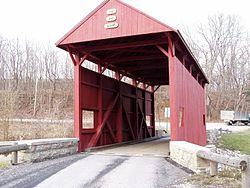 Interior structure of a covered bridge that uses a queen-post structure | |
| Ancestor | Truss bridge |
|---|---|
| Related | None |
| Descendant | None |
| Carries | Pedestrians, livestock, vehicles |
| Span range | short to medium |
| Material | wood planks |
| Movable | No |
| Design effort | medium |
| Falsework required | Sometimes |
A queen post is a tension member in a truss that can span longer openings than a king post truss. A king post uses one central supporting post, whereas the queen post truss uses two. [1] Even though it is a tension member, rather than a compression member, they are commonly still called a post. A queen post is often confused with a queen strut, one of two compression members in roof framing which do not form a truss in the engineering sense. [2]
Contents
The double punch truss appeared in Central Europe during the Renaissance. [3]
